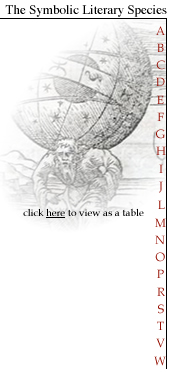
The Symbolic Literature of the Renaissance


Support the Library!
Buy your books here.
home
authors
books
contributors
books for sale
links

| ||||
|
|
The Library of Renaissance Symbolism The Symbolic Literature of the Renaissance |
 
|
||
|
Support the Library! |
Find On Worldcat |
Find On This Site |
||

|
The Bestiaries were a large genre of medieval books on the symbolic significance of animals. The genre became extremely popular by the 12th century particularly in England but was based on the much earlier Over the centuries, the standard format of the Physiologus expanded from just forty-nine entries to over one hundred. Many of the animals described, such as the Unicorn, the Phoenix, the Centaur, the Siren and the Antlion, are now known to be fictitious but this did not deter the editors at the time. St. Augustine had validated the genre since according to him it did not matter whether certain animals existed or not, what mattered is what they signified. ‘Moreover, if for the administration of the sacraments, certain symbolisms are drawn, not only from the heavens and stars, but also from all the lower creation, the intention is to provide the doctrine of Salvation with a sort of eloquence, adapted to raise the affections of those to whom it is presented from the visible to the invisible, from the corporeal to the spiritual, from the spiritual to the eternal.’
Gesner’s vast tome of some 3,500 pages published from 1551-1587 is usually reckoned to be the first modern work of zoology, but nevertheless, each of his descriptions is prefaced with a symbolic interpretation of the animal he was describing. Another contemporary revival of the Bestiary was the Decades de la description …des animaulx of 1549 by Aneau and Gueroult both of whom also wrote emblem books. And there were books of emblems and devices which had animal themes such as Symbolorum & Emblematum Centuria, a Century of Symbols and Emblems, by Joachim Camerarius. Another genre which had developed in the late Middle Ages was called the beast fable or beast epic of which one of the most celebrated was the Roman de Renart from the 12th Century, a series of satirical tales which inspired one of Chaucer’s Canterbury Tales. The beast epic did not falter in popularity and versions were written by many later authors including Spenser and Dryden. Birds also had symbolic significance for medieval Christians and many of the bestiaries had entries on birds. The formal title for a collection of the exposition of the symbols of birds is a volucrary and the most widely known volucrary in the Renaissance was that by Jean de Cuba in his book Jardin de Santé which describes 122 birds and gives pertinent extracts from the relevant classical authorities. See also: Herbals, Lapidaries
|